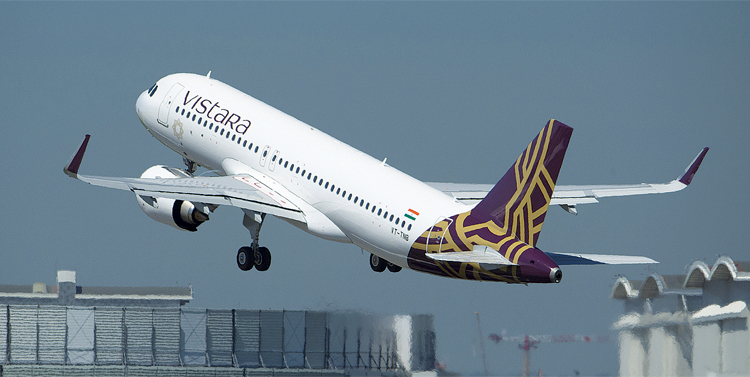Tata Group Riding the Ambitious Aviation Arc
Having raised its stake in AirAsia India, alongside operating Vistara, Tata Group is a strong bidder for Air India too

As the entire aviation industry grapples with uncertainty and hopes for recovery, the Indian aviation industry seems to be preparing for a distinct ride. Where on one hand we have airlines coping with sustaining themselves, the Tata group appears to be on an ambitious arc to ace the aviation sector in the nation.
In one of its recent report, aviation consultancy firm, Centre for Asia Pacific Aviation (CAPA) India highlighted some trends that the Indian aviation industry is likely to witness. One of the important points put forth by CAPA India was that the Indian airlines industry is heading towards consolidation and it could result in a 2-3 airline system in the near to medium term.
At present, the Tata group indeed presents a likely evidence for this prediction by CAPA. Tata Sons had recently marked this New Year with a raise in its stake in AirAsia India. Tata Group had increased its holding in the India-based joint venture with AirAsia that started in 2014, to about 84 per cent from 51 per cent, having bought an additional 32.67 per cent stake from AirAsia Berhad at about 276.69 crore. The Tatas also possess a call option of buying out the remaining 16.33 per cent, under the share-purchase pact. Currently, Tata already operates the Vistara airline in partnership with Singapore Airlines owning a 51 per cent stake in the full service carrier. In addition to these, Tata Sons is reportedly a serious contender for the national carrier Air India. The winning bidder for Air India will also acquire its profit-making and low-cost subsidiary, Air India Express.
Tatas can also gain monopoly on international routes
If Air India returns to the Tata Group, that had sold the airline to the government over six decades ago, the Tatas have a strong chance to become the second largest player in the Indian domestic aviation market, IndiGo being the market leader. Tatas can also gain monopoly on international routes, going by the current scenario, especially given the absence of Jet Airways. The space for an Indian carrier remains significantly absence in the international routes.
In a report last year, the Directorate General of Civil Aviation (DGCA) had also stated that if the Tatas bag Air India and eventually consolidate their aviation interests, their likely domestic market share would be about 23 per cent. That would make it a formidable number two in the Indian aviation market. The consolidation can also come around with all the three airlines being merged under one brand, all of which though depends on number of factors including the COVID-19 situation, routes available, the balance sheets, agreement with the Singapore Airlines, the government, etc. If the consolidation takes place, the Indian aviation can transform from a six player industry to a four-player one comprising the Tatas, IndiGo, SpiceJet and GoAir. The Tatas would then have domestic market share of about 23 per cent (Air India 10.3 per cent, Vistara 6.3 per cent and AirAsia India 6.6 per cent as on November 2020).

Owned by Malaysian businessman Tony Fernandes, AirAsia has had a challenging year, trying to sail through the COVID pandemic amid cash burns. The Malaysia-based budget carrier, posted its biggest-ever quarterly loss in August and recently shut down its Japanese subsidiary. Going further, the aviation industry does not seem to witness a sudden boost, rather as CAPA India put it, airlines will have to carry the costs of a large proportion of their fleet remaining grounded, especially those that were earlier deployed on international routes.
InterGlobe Aviation Ltd, which runs IndiGo, is the market leader with a daunting share of 53.9 per cent. Of course, for consolidation, it is essential that the Tatas first simplify the complex structures with its partners in existing airlines, and progress on that front will be keenly watched. “A strategic consolidation among Indian airlines is inevitable and could result in the total number of airlines coming down from six,” CAPA India stated.
While the Tatas will gain a strong position in the sector if the acquisition of Air India comes through, it will be quite a challenge for them to navigate the three especially when Vistara and AirAsia India have together lost around $845m, according to the Centre for Asia Pacific Aviation (CAPA), with COVID-19 exacerbating the challenges facing the airline industry.
But the past record of Tata’s aviation industry makes way for hope. The Tatas’ aviation history can be traced back to more than 80 years ago. It was in 1932 that JRD Tata undertook India’s first air service flight and went on to become the pioneer of civil aviation in the country In 1953, Tata Airlines, which was founded by JRD Tata, was nationalised and became Air India.
From Tata Air Lines and the long-since nationalised Air India to strategic joint ventures with AirAsia Berhad and Singapore Airlines (SIA) for AirAsia India and Vistara, respectively, Tata has had a constant presence in the aviation industry. The two joint venture airlines operate independently with their respective business models – low-cost (AirAsia) India and full-service (Vistara).
Vistara scaled up its operations significantly in 2019 by adding nine Boeing 737-800NG aircraft to its fleet and taking the final count of aircraft to 31 which helped the airline expand its network by more than 50 per cent.
AirAsia India commenced operations in 2014 and has 23 aircraft; it flies to 21 destinations across India with 630+ weekly flights. Into its fifth year of operations, AirAsia India has ambitions now to connect more Tier II and Tier III cities within the Indian subcontinent and a long-term view of going international.





